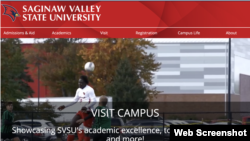Student Union
Third of Student Debt Owned by Only 6% of Borrowers

One-third of outstanding U.S. student loan debt is owned by only 6% of all student loan borrowers, according to a new report.
The public policy nonprofit Brookings Institution released a report this week clarifying where all of that $1.5 trillion student debt comes and goes.
"A very small fraction of all student loan borrowers have very large loans. Six percent of borrowers owe more than $100,000 in debt, with 2% owing more than $200,000," the report by Brookings' Kadija Yilla and David Wessel found. "This 6% owes one-third of the outstanding $1.5 trillion of debt.
"At the other extreme, 18% of borrowers owe less than $5,000 in student loan debt. They collectively owe 1% of the debt outstanding," the report stated.
About one-quarter of those with student loans borrowed for graduate school, Brookings said, but that one-quarter owns about half of all outstanding student loan debt.
"While only a small share of households with student debt have a graduate degree, loans associated with graduate degrees account for 50% of the total outstanding student loan debt," the report said. Households with student debt headed by someone without a bachelor’s degree account for only one-quarter of total outstanding debt.
And those who owe the most are not the ones defaulting on debt, the Brookings report said.
Brookings said borrowers with graduate degrees who own half of all student debt are the least likely to default. Who has higher default rates? Those who attend for-profit universities, like DeVry and the University of Phoenix.
In February 2018, U.S. President Donald Trump was required to pay $25 million to settle class-action lawsuits accusing Trump University of fraud after failing to deliver on promises to teach students how to succeed in the real estate sector.
"Forty percent of borrowers from for-profit, two-year programs default on their loans within five years," the report said. Just under one-third of borrowers who attended for-profit four-year programs "defaulted in this same timeframe."
Among students who borrowed to attend public community colleges, about 25% default within five years of entering repayment.
Defaults are much less frequent among those who borrowed to go to public or private nonprofit four-year schools.
Student debt is not all about tuition. In some cases, room and board, books, transportation and other living expenses cost well above tuition.
"Many students borrow to not only cover their tuition and fees but also to get cash to finance the cost of living while they are in school," Brookings reported.
Some public schools offer students "tuition free" financial aid. But that doesn't include the dorm or rental housing, or food. For students at public universities and colleges who pay no tuition, 22% borrow $30,000 or more. The average student borrows $24,000, Brookings said, based on an Urban Institute analysis conducted using the National Postsecondary Student Aid Study.
And what about all those young college students receiving bachelor's degrees from four-year colleges and universities? They graduate with little to no debt, Brookings said.
"Thirty percent of all bachelor’s degree recipients graduate with no debt," Brookings reports. "Another 23% graduate with less than $20,000 in loans."
Fewer than 20% of all borrowers owed more than $40,000. Only 12% of those who attended four-year public colleges owed more than $40,000.
See all News Updates of the Day
Bangladeshi protesters demand end to civil service job quotas

Thousands of Bangladeshi university students threw roadblocks across key highways Sunday, demanding the end of "discriminatory" quotas for coveted government jobs, including reserving posts for children of liberation heroes.
Students in almost all major universities took part, demanding a merit-based system for well-paid and massively over-subscribed civil service jobs.
"It's a do-or-die situation for us," protest coordinator Nahidul Islam told AFP, during marches at Dhaka University.
"Quotas are a discriminatory system," the 26-year-old added. "The system has to be reformed."
The current system reserves more than half of posts, totaling hundreds of thousands of government jobs.
That includes 30% reserved for children of those who fought to win Bangladeshi independence in 1971, 10% for women, and 10% percent set aside for specific districts.
Students said only those quotas supporting ethnic minorities and disabled people — 6% of jobs — should remain.
Critics say the system benefits children of pro-government groups, who back Prime Minister Sheikh Hasina.
Her father, Sheikh Mujibur Rahman, was Bangladesh's founding leader.
Hasina, 76, won her fourth consecutive general election in January, in a vote without genuine opposition parties, with a widespread boycott and a major crackdown against her political opponents.
Critics accuse Bangladeshi courts of rubber-stamping decisions made by her government.
The system was initially abolished after weeks of student protests in 2018.
But in June, Dhaka's High Court rolled that back, saying the cancellation had been invalid.
'Wasting their time'
Hasina has condemned the protests, saying the matter had been settled by the court.
"Students are wasting their time," Hasina told female activists from her party Sunday, Bangladeshi newspapers reported.
"After the court's verdict, there is no justification for the anti-quota movement."
Protests began earlier in July and have grown.
"We will bury the quota system," students chanted Sunday in Bangladesh’s second city Chittagong, where hundreds of protesters marched.
In Dhaka, hundreds of students disrupted traffic for hours, police said.
At the elite Jahangirnagar University, at least 500 students blocked the highway connecting the capital with southeastern Bangladesh "for two hours," local police chief A.F.M. Shahed told AFP.
Bin Yamin Molla, a protest leader, said at least 30,000 students participated in the protests, although the number could not be verified.
Bangladesh was one of the world's poorest countries when it gained independence in 1971, but it has grown an average of more than 6% each year since 2009.
Hasina has presided over that breakneck economic growth, with per capita income in the country of 170 million people overtaking India in 2021.
But much of that growth has been on the back of the mostly female factory workforce powering its garment export industry, and economists say there is an acute crisis of jobs for millions of university students.
International students navigate financial challenges to pay US tuition

Navigating the complexities of higher education is challenging for many, but for international students, the financial hurdles can be particularly daunting.
Faced with skyrocketing tuition and fees, limited access to financial aid, and the instability of scholarships, many international students struggle to sustain their academic dreams.
Funding problems can lead some students to withdraw their college applications, as Alpha Daramy Sesay of Sierra Leone did. He abandoned his dream of studying journalism at the University of Maryland.
"I've applied to almost three universities in the past two years, and the board members were thrilled with my purpose statement and approved my application unambiguously," Sesay told VOA News. "However, I was unable to register due to the funding bottleneck, and the deadline for these offers has just lapsed."
Sesay had meticulously planned his move to the U.S., even stopping his scholarship search when a family member promised financial support. When Sesay was admitted to his dream school, however, the family support fell through, leaving him scrambling for scholarships that didn't cover all expenses.
Reflecting on his ordeal, Sesay advises future international students to seek scholarships and consult with school advisers early to avoid similar setbacks.
Talia Popovski, senior director of International Student Services at Valencia College in Orlando, Florida, suggests starting at a community college to save on tuition costs.
"Primarily, we have international students pursuing associate degrees," she said. "This is a major way for them to save money compared to going directly to a university."
Popovski emphasized the benefits of community colleges as pathways to universities, with many international students pursuing associate degrees before transferring to earn their bachelor's degrees. She also highlighted the role of on-campus work in alleviating financial burdens, suggesting institutional work-study programs as options.
According to NAFSA: Association of International Educators, a nonprofit dedicated to international education and exchange, international students are ineligible for federal work-study positions, necessitating discussions with advisers about employment eligibility. Popovski also mentioned that universities offer part-time jobs through their human resources departments, including paid internships, which provide additional financial support for education.
Student secures honor scholarship
Guilherme Lucas Mannarino, who received his associate degree from Valencia College, turned down 32 esports scholarships to study in Florida.
"I came to the United States [from Brazil] when I was 18 years old," Mannarino recalled. "I rejected all the scholarships that I acquired through esports, playing Fortnite."
Mannarino, who majored in finance at Valencia College, exemplified proactive planning in overcoming financial challenges.
Despite declining the esports scholarships, Mannarino secured an honor scholarship at Valencia College covering 50% of his tuition. He attributed his financial stability to planning ahead, staying on top of his academics, and acquiring an on-campus job.
To supplement his income, he conducted workshops advising Brazilian students on esports scholarships, allowing him to cover living expenses by finding roommates through social media.
"I was able to find a roommate on social media before coming to the U.S., which is a great way to save money," he said. "A year later, we had another roommate, which made my living costs cheaper, which is honestly the best way to save money in the U.S."
Tips for overcoming financial hurdles
Kadiatou Sow, from Conakry, Guinea, is studying at Saginaw Valley State University in University Center, Michigan.
"Managing the high cost of tuition and living expenses while studying abroad involves a strategic approach," Sow said. "I prioritize securing scholarships and grants tailored for international students to alleviate tuition expenses and sometimes cover living costs. Supplementing this with part-time work both on campus and in the local community provides a steady income for daily necessities."
She encourages fellow international students to balance work and studies effectively, understand visa work-hour regulations, and seek university support for financial aid options.
"Seeking guidance from university support services and staying informed about financial aid options are essential strategies for navigating these challenges successfully," Sow said.
Three ways international students can overcome financial hurdles:
1. Community college enrollment: Begin with an associate degree at a community college to save significantly on tuition costs before transferring to a university for a bachelor's degree.
2. On-campus employment: Explore institutional work-study programs and university job boards for part-time employment opportunities that complement studies and provide financial support.
3. Proactive financial planning: Save money before arriving in the U.S., seek scholarships tailored for international students, and explore paid internship opportunities to supplement income.
While financial obstacles are daunting, international students can achieve their academic aspirations through strategic planning, diligent scholarship pursuit and leveraging on-campus resources, advisers say.
By adopting proactive financial strategies and staying resilient, they can successfully navigate the challenges of financing their education abroad, ensuring a path to academic success and personal growth.
- By VOA News
Indian newspaper offers tips for US-bound students

Telangana Today, a newspaper in India, offers a list of tips and resources for students planning to study in the United States.
Among them:
- Prepare for your travel to the U.S., making sure to gather all necessary documents, including your passport and visa.
- Be sure to attend orientations.
- By VOA News
Michigan State international students get their own space

Michigan State University in East Lansing, Michigan, is setting aside a space in the International Center for international students.
Nidal Dajani, vice president of the school's International Student Association, said that the club plans to use the space to host events and hopes to collaborate with other student groups.
- By Dylan Ebs
International students find community during Pride Month

For LGBTQ+ international students, Pride Month, observed in June, is a unique time to reflect.
They hold on to multiple identities — both their LGBTQ+ identity and their cultural background — but coming to terms with them is not always easy.
For graduate student David Zhou, these identities can feel conflicting as transgender rights in China remain a controversial issue and spaces for LGBTQ people close. Zhou, 25, is transgender and pursuing an education in the STEM field at an urban university in the Midwestern United States.
VOA is using a pseudonym for Zhou’s first name and is not naming his university to protect his identity due to safety concerns back home in China. Zhou is not open about his transgender identity to his family.
During Pride Month, Zhou said he attended multiple LGBTQ+ events in his community and is surrounded by a supportive group of LGBTQ+ students who can relate to his experiences. But he’s not open about his identity to everyone on campus and said he doesn’t disclose his preferred pronouns to everyone to avoid transphobic comments.
“I feel like I have to make some judgments of the character of that person to see if they’re a good person to disclose [my identity] to,” Zhou said.
Zhou’s Pride Month celebrations included attending local markets with LGBTQ+ vendors and hanging out with his LGBTQ+ friends.
“They normalized being trans and for a long time I feel like trans identity is, should I say a vulnerability, brings me fear and worrying about discrimination, but having those events are helpful because it allowed me to see that queer people could just [live] openly,” he said.
At social events where few international students are present, Zhou said it can be tough to fit in.
“There's a lot of times like when they were talking about things I kind of, don't really understand, mostly because I kind of lack some background experience or knowledge,” he said.
Zhou said he is not aware of specific groups for LGBTQ+ international students at his university, but said international students are more prevalent in graduate programs and therefore find representation in organizations for LGBTQ+ graduate students.
In China, transgender individuals must obtain consent from an “immediate family member,” even for adults hoping to transition, which critics say limits the autonomy of transgender individuals while supporters say the policy protects doctors from violence by upset parents.
Struby Struble, a former coordinator of the University of Missouri LGBTQ+ Resource Center, told NAFSA: Association of International Educators in 2015 that LGBTQ+ international students face a “double barrier” on campus.
“With their international student friends, they feel isolated because they’re the LGBT one,” she said. “But then among the LGBT students on campus, they feel isolated because they’re the international one.”
Nick Martin, associate director of the Q Center, Binghamton University’s LGBTQ+ student support office, said when international students tour the center, there’s often a sense of hesitation as they enter a type of space that may not be present in their home country.
“I compare that to a year in after they've come into the space, they've again, maybe come to some of our events, they've got more connected,” he said.
Martin said graduate students have a unique interest in the Q Center as they may use the office for research and advocacy purposes that align with their studies.
“For older students, there may be hesitancy in a different way, but I think it's more in the vein of they want to do some of the advocacy work,” he said.
Martin said he thinks about how both his office and BU’s international student office can support students who come from countries with few — if any — protections for LGBTQ+ individuals.
“It's been a learning process of what those students really need, but I think I've kind of learned that a lot of students are just looking for the safe space that we offer,” Martin said.







